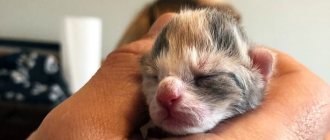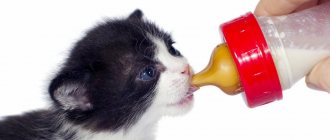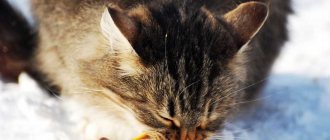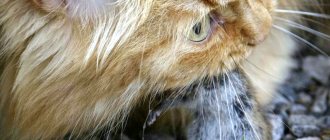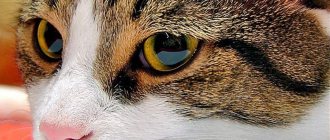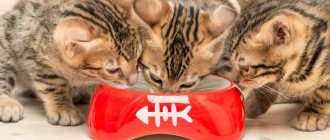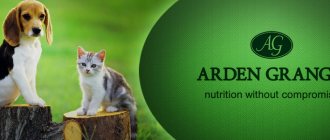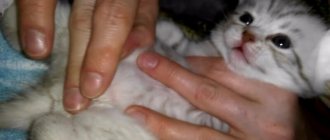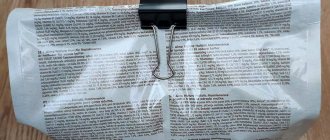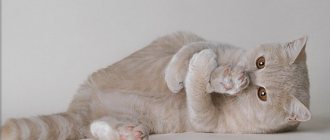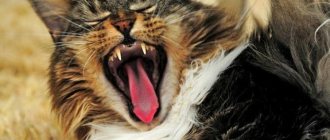Dry food is not only suitable as the first independent food in the life of small pets, but is also the best option. But there is one amendment: the product must be of high quality, balanced and designed specifically for kittens. Why is this so important?
The fact is that babies grow very quickly, they have an accelerated metabolism and for proper development they need nutritious food containing a full range of vitamins and minerals. High-quality feed is developed taking into account the needs of the body during the period of rapid growth and development and daily saturates it with all the substances necessary for this. It is impossible to achieve the same result with natural feeding. That is why, with this type of feeding, pets are also given additional vitamin and mineral supplements. In addition, it is worth considering that kittens have sensitive digestion. Incorrectly selected or insufficiently high-quality products can lead to serious digestive disorders or even poisoning, so you need to be careful in this matter. In addition, do not forget that sudden changes in food cause a blow to the body of even an adult healthy cat, and with fragile babies you need to be much more careful.
Features of feeding a kitten with industrial food
Kittens can drink their mother's milk for up to 2 months or more. But a growing body requires more useful elements and nutrients, which can be additionally obtained from natural products or industrial diets. The latter products are given greater preference, but only if they are of high quality.
Rules for feeding prepared rations:
- Dry granules can be introduced into a kitten’s menu from the age of 3 weeks to 1 month, depending on the characteristics and pace of its development. The optimal time is when the baby's teeth are cutting through and he begins to show interest in solid objects.
- Dry food is healthy and excellent for kittens, but giving it as the only product present in the diet is allowed provided that the owner will continue to feed it to the pet in the future.
- It is correct to introduce your baby to new food - before introducing the kitten to hard granules, they need to be soaked in water or milk.
- Choose a quality product that replenishes the lack of vitamins and minerals for a growing body.
Nutritional standards by weight, table
Overfeeding and not enough food are equally harmful to cats. Feed dosages are indicated on the packaging; they differ from manufacturer to manufacturer. If the owner combines “drying” with wet food, you need to ensure that spiders account for no more than 25% of the total diet. They are quickly digested, cats love them and eat much more than they need. This can quickly lead to obesity and related problems.
We present the average normative data in the table:
| cat weight (kg) | daily norm when feeding only dry food (g) | daily intake for mixed nutrition (g) |
| until 3 | 25 | 15 + 1 spider |
| from 3 to 4 | 40 | 25-30 + 1.5 pouches |
| from 4 to 5 | 60 | 25–45 + 1.5 pouches |
| more than 5 | 12 g per kg of weight | 35–60 + 2 spiders |
These standards are average. Various factors influence the amount of feed consumed. The main ones:
- age of the cat;
- pet's activity level;
- breed;
- health status;
- gender
Most manufacturers produce lines of food for different individuals (for example, for active or couch potatoes, for kittens, adults or elderly, for sterilized individuals, and others). Even for hairless breeds there are specialized foods. So if you have a Sphynx, Elf, Bambino, Dwelf, Minskin or Ukrainian Levkoy, there will be no problems. In addition to following the instructions on the package, it is advisable to consult with a veterinarian, who will give the necessary recommendations on the rate of food consumption and the type of feeding of a particular individual.
The class of food has a great influence on the amount of food required. The higher it is, the fewer granules are required to saturate the cat. Accordingly, the consumption of economy class feed with low nutritional value will be much higher than that of super-premium or holistic products.
Dry food for kittens
How to choose dry food for a kitten
There are many industrial feeds. They differ in their prices, tastes and benefits for a growing body. You should choose food intended directly for kittens. You should not give your baby food designed for an adult animal.
Optimal options.
The highest quality food is in the holistic category. It contains only natural products and is a complete replacement for natural food.
But holistic products have one drawback - their high price. And since it is not recommended to switch the kitten to lower quality food in the future, the owner must immediately decide whether he can support the expensive food for his pet.
Super-premium and premium-class feeds are also of good quality. Giving your pet Budget Economy is not recommended. These foods contain few natural products and many harmful food additives.
Studying the label. When choosing food, you should carefully study its composition:
- Meat should be listed first on the list of ingredients. This is a source of protein necessary for the full development and active growth of a kitten. It is not recommended to choose food that contains offal as a source of protein.
- Wheat – this ingredient should not be present in high-quality food. This cereal is poorly absorbed by the kitten's digestive system. In addition, it is a strong allergen.
- Fats – may be present in food, but only of animal origin.
- Omega 3 and 6 fatty acids . These substances are very useful and important for a growing organism. Omega fatty acids have a positive effect on the immune system and keep the animal's skin and coat healthy and beautiful.
- Prebiotics are very good if they are included in kitten food. Such ingredients help improve digestion and maintain the balance of beneficial intestinal microflora. Prebiotics are especially useful for kittens whose gastrointestinal tract does not yet work smoothly and may have problems digesting food.
- Yucca Schidigera . This component is included in high-quality dry food. Yucca extract helps in the absorption of food, normalization of metabolic processes and reduction of flatulence.
If these components are included, the product will be of high quality and suitable for kittens over 1 month of age.
Table: overview of the four most popular brands of kitten food
| Brand | The first 10 ingredients in the composition | Average cost 1 kg | Advantages | Flaws |
| Royal Canin |
| 600 rub. | Thanks to the use of easily digestible components, the load on the gastrointestinal tract is reduced, so the chance of developing pathologies even in the presence of risk factors is minimal. Despite the weak composition, sometimes Royal Canin food does not cause side effects in kittens with sensitive digestion. | Overpriced. The manufacturer uses too many anonymous ingredients and isolated protein instead of whole muscle tissue. |
| Orijen |
| 700–800 rub. | The food mainly consists of meat. The list of ingredients includes preventive additives. Pears, apples and other fruits and berries prevent the development of KSD. Plant components contain fiber, which is necessary for the proper functioning of the gastrointestinal tract. Fish contains unsaturated fatty acids that help strengthen the immune system. The line includes a special food that is suitable for kittens, which is not typical for holistic people. | High price. The food is not suitable for all kittens due to excess meat and fat in the composition. If the baby has previously eaten products from another brand, it is better to postpone the transfer. |
| Acana |
| 700 rub. | Contains enough meat. The composition contains preventive additives: cartilage, tripe, turmeric, etc. They improve digestion, maintain healthy joints and strengthen the immune system. The manufacturer states that all food in the line is suitable for both adult cats and kittens. | High price. Compared to Orijen foods, Acana products contain less meat. |
| Go! |
| 500 rub. | The line includes whole grain and grain-free food, as well as a dietary diet for cats and kittens with sensitive digestion. The cost is reasonable. | Whole grain food contains too many grains. |
How to give dry food to a kitten
Dry granules cannot be given to a one-month-old baby in its pure form. The fact is that the kitten’s teeth are not yet strong enough to gnaw on them, and difficulties may arise with the digestion of such food. To accustom your pet to commercial food at such a young age, it should be properly prepared:
- The granules will need to be filled with low-lactose milk. If you are unable to purchase this product, you can use low- or medium-fat kefir, lean meat broth, or boiled water to dilute the food. Liquids should be at room temperature.
- Cover the container with filled granules with a lid. It is necessary to insist until the granules become soft.
- Crush the softened granules with a fork until smooth.
- If the kitten does not show much attention to new food, you can add a little meat to the crushed food, for example, boiled chicken, but without the skin.
- As the kitten begins to get used to the new food, the amount of liquid for stirring the granules should be reduced.
- During the period of accustoming the kitten to dry food, you should not give it other food. The pet must remember that there is only one food - pellets. This method will help the kitten get used to commercial food faster.
Unmixed dry food should not be given immediately. The kitten will not be able to chew it completely, and hard pieces with sharp corners can injure the kitten’s esophagus.
Weaners
When new owners acquire a kitten, they must ask what food the previous owners used, and do not change the diet for the first few days. Then you need to make a choice of the product that the baby will eat. The transition from one food to another should be carried out smoothly, over 1–2 weeks. The percentage of the old feed gradually decreases and the share of the new feed increases. If the kitten was fed wet formula or natural food, and the owner wants to switch to a dehydrated diet, there may be a need to accustom him to a new food through the soaking stage.
At three months of age, a teenager's teeth begin to change. If the owners of the animal intend to engage in breeding and attend exhibitions, they must by this time decide on the final choice of food. Four-month-olds can eat junior food or food intended for adult cats.
When can a kitten eat dry food in its pure form?
You can give unsoftened granules no earlier than the pet turns 3 months old and only on the condition that by that time he is already eating commercial finished products. Rules and recommendations for feeding a kitten with dry food in its pure form:
- It is recommended to choose food from one manufacturer and in the future buy only that for your pet. You should not change brands, as this may negatively affect the kitten’s health.
- Give only the serving size indicated by the manufacturer on the packaging. At such a young age, the kitten cannot yet control its satiety. He has a way of eating everything that is poured into his bowl. This is fraught with problems with the digestive system and obesity in adulthood.
- Be sure to follow the drinking regime. Dry granules contain no moisture at all, and the water requirement of a growing organism is high. Therefore, the kitten’s bowl should always be filled with clean, fresh water. It needs to be changed at least 2 times a day.
Mixed type. If it is not recommended for adult cats to mix industrial food and natural products, then the situation with kittens is somewhat different.
Veterinarians recommend, in addition to dry food, to give kittens calcined cottage cheese, kefir of minimal or medium fat content, lean meat and boiled chicken fillet without skin.
But combining dry granules and natural food in one bowl is strictly prohibited. These foods should be divided into several meals.
To summarize: how should cats be fed?
Fanaticism on any issue is bad. If you are assured that cats need to be fed only natural food or only food, the person does not understand the issue, but blindly believes in his “theory”.
Whether to feed your cat dry food is up to you. It has both advantages and disadvantages. One thing is certain - choose industrial feed if you don’t have time. Meal planning and cooking takes effort.
Porridge with fish is no better than Whiskas, and fresh rabbit meat is no cheaper than holistic food. Both food and natural food can be fed in very different ways.
You need to focus on the result. If a cat has shiny fur, perfect plasticine poop, optimal physical fitness and activity, then the food is suitable for her.
What food is suitable for a kitten?
Even the smallest and most touching fluffy ball is a real predator by nature, which needs a diet rich in animal protein. Only meat is a complete food for cats, from which their body extracts all the nutrients, vitamins and microelements it needs. Therefore, when choosing food, you should focus on the content of meat ingredients - there should be more of them in the composition than any other components.
In addition, you should pay attention to animal fats - replacing them with vegetable oils is unacceptable, since from the latter the body of carnivorous animals will not be able to obtain valuable Omega-3 polyunsaturated fatty acids, which are important for the formation of the brain and nervous system of kittens. Read more about the selection criteria in the article “What dry food to feed a kitten.”
The combination of dry food and regular food in the diet of kittens
There are three types of pet feeding:
- dry and wet industrial feeds;
- home-cooked food;
- mixed type.
Quite a lot of breeders use the third type of feeding, combining dry food and regular food, and justify this by the fact that manufacturing companies make diets that do not meet the physiological needs of animals. Owners feed their cats alternately dried and natural food, or offer them raw meat as supplementary food.
Some animals are on a mixed type of feeding until they are very old and remain healthy, but still this approach is not entirely safe and can cause health complications due to the functioning of the cat’s digestive system, which produces certain enzymes to break down food groups.
Even the transition from one nutrition system to another sometimes lasts about a month, and in the case of mixed feeding, the body experiences stress and may fail. When contacting a clinic, it will be quite problematic to understand what caused the functional disorder and this will complicate therapy.
Some products in combination with dry food can become a “time bomb”. This primarily applies to fish.
The diet strictly maintains the phosphorus-calcium balance, which is important for cats because they are susceptible to urolithiasis. An additional source of minerals can lead to pathologies of the urinary system.
Dry food and meat
Some cat owners use chicken and other meat products as treats or rewards. Good food does not require additional feeding of animals, and in some cases such actions can harm the pet.
By purchasing super-premium or holistic diets, where the content of meat components is as close as possible to the diet of wild cats, pet owners can be sure that the daily dose is enough to keep the animal full and feeling good.
A few pieces of meat will not harm a cat, but sometimes this leads to a situation where the animal refuses to eat dry food, preferring natural food. Meat is a natural food for most cats; its taste and texture are embedded in the animal’s genetic memory, so convincing your pet that dry kibble is more interesting can sometimes be problematic.
Dry food and milk
A significant portion of kitten owners believe that milk is quite suitable for “washing down” dry food, performing the functions of water. This is a very serious mistake, sometimes leading to the death of the animal.
There are three reasons for this:
- Milk is an additional source of calcium in the diet: the dangers of calcium imbalance were discussed above.
- Cow's milk is not a natural food for cats: in nature it is a natural food for calves. In the diet of cats, milk is used in the most extreme cases (when feeding kittens at an early stage of life in situations where it is not possible to purchase special cat milk substitutes).
- Adding milk to your cat's diet reduces her water intake. Milk is more of a food because of its nutritional value. Dry food requires a lot of water due to its dehydration.
Water is an integral attribute of feeding a cat, a vital component, the restriction of which leads to serious illness and even death of the animal.
Owner reviews of Whiskas dry food
Alina, Moscow
We picked up our cat on the street when she was about 4 months old. She is mongrel, but the most beautiful and smart. As soon as we had her, we started buying her Whiskas. I am very pleased with the choice of flavors and quality. The cat likes the salmon flavored pillows best. We alternate flavors, the cat is delighted. And we are very happy for her. She simply won't eat any other food. Thank you, Whiskas, for being with us. And thank you for making our pets happy!)
Aleks312, Kirov
It is better to listen to the taste desires of your pets than to take just anything. Our cat is very picky. If he doesn’t like the smell of the food, then he won’t eat it. Therefore, at first there were difficulties with feeding. Now we only buy him what he likes. We give him Whiskas in different forms: he eats jelly, stew, and dry food with gusto. We recently bought a new flavor to try - with beef and rabbit.
Ate absolutely everything. He even asked for more. So after a while I had to go and get it again. The packaging itself is beautiful. It catches your eye immediately, there is no specific smell...
Dry food is a complete and balanced diet for your pets. Accustom them to a new diet with affection and patience, in return you will get a healthy animal.
Basic questions: is it possible
Experienced kitten owners usually have no questions about what can and cannot be given to their pet. When the first kitten appears in the house, its nutrition raises many questions.
They are overwhelmingly typical, and these are the ones that will be discussed further.
Canned food
Canned food that is designed specifically for cats, if they are age appropriate, can definitely be given to your pet, but only when the kitten already knows how to drink water on its own. When it comes to products for the master's table, they are completely prohibited.
This is due to the fact that they contain salt and spices that should not be given to cats. Canned food for people, even of the highest quality, poses a serious danger to a kitten.
Meat baby food and formula, how to dilute
Baby food is often used to feed kittens. For sucklings who are left without a mother, if it is not possible to purchase cat milk substitutes, high-quality infant formulas are used. They are diluted with water in a ratio of 1:1.5. Infant formula is also used if the kitten has diseases that do not allow it to eat normally. Some breeders also use milk formula for children to begin accustoming the baby to adult nutrition.
Meat baby food is a good replacement for special pates and mousses for kittens. The main thing is that such food does not contain any admixture of salt and starch. The most popular is Agusha meat puree, which is distinguished by its high quality and affordable price.
Cow's milk, what can you replace it with?
Kittens need milk until they are 3 months old. Natural boiled cow's milk is the best option. When this is not possible, you should use packaged milk from a non-perishable store. Its fat content should be from 3.2% to 6%. A low-fat product cannot be used.
You can replace cow's milk with goat's or sheep's. However, it will first have to be diluted with water in a 1:1 ratio. Only after making sure that the kitten’s body accepts it normally can it be possible to give the product in its pure form. Sugar-free concentrated milk is also suitable as a substitute. As a last resort, you can dilute powdered milk for the kitten. Cream with a fat content of 8-10% is given to kittens no more than 2 times a week, so as not to overload the liver and pancreas.
At what age is milk allowed?
You can start giving milk to kittens at 3 weeks. Until this age, they should receive mother's milk or, if it is not available, then substitutes. Enzymes for the digestion of whole milk will remain in the kitten for up to 3 months. Because of this, the product should only be given to your pet from 3 weeks to 3 months. Then it is replaced with fermented milk.
Sour cream is prohibited!
Sour cream
Sour cream is a high-fat product, which is why it is not suitable for kittens. His digestive system will not be able to cope with such a load, and diarrhea and vomiting will occur.
If you feed sour cream regularly, then there is a risk of problems with the liver and pancreas. Adult cats can sometimes be given a little sour cream with a fat content of no more than 15% as a treat.
Raw meat
Cats are carnivores by nature, and their diet must include raw meat. It begins to be given from the age of 5 months. You should purchase meat from trusted stores so that the quality of the product is always high. You can only give lean beef, rabbit, white chicken and turkey.
For your information! Pork is strictly prohibited for cats as well as for most dogs!
Dog food
Dog food is not suitable for cats as they have different nutritional needs. The former are omnivores, while cats are predators. Because of this, the amount of protein they receive must be significantly higher than what dogs need. Because of this, with constant feeding of dog food, the kitten will begin to develop systemic disorders, which pose a direct threat to its life. A single use will not harm the kitten. Because of this, you shouldn’t be afraid that your pet will grab food from the dog’s bowl, but you shouldn’t specifically feed it to the kitten. Proper nutrition for dogs is different from that for cats.
Dry food only
Most veterinarians recommend giving dry food to kittens only from the age of 2 months. Before this, the jaw apparatus is not yet strong enough to easily chew granules, and the intestines are more suitable for soft nutrition. If for some reason you have to give your baby dry food, then they should be soaked. It is not advisable to feed cats at any age only dry food. They should also receive wet food, as this is necessary to maintain a healthy stomach and intestines.
Adult for cats
Adult cat food should not be used for kittens. They do not contain all the substances necessary for a growing body, which is why the kitten will start to get sick. Also, such food is too rough for babies and can cause stomach problems. If you need to give food to adult cats once, they should first be soaked.
Warning! When feeding a kitten with prepared food, there is no need to additionally enrich its diet with vitamins and minerals, since they already contain everything they need.
Food from our table is strictly prohibited!!!
Homemade food from the table
Giving a kitten food from the owner's table is only permissible if the person follows a strict diet, when salt, sugar, spices, vinegar, spicy, fried and smoked foods are completely excluded from the diet. With a normal diet, the owner should not treat the pet with food from his table.
With such food, he will receive extra fats, calories and preservatives that are harmful to him, and spices, salt or sugar will negatively affect the functioning of the intestines and kidneys.
In families with children, you should immediately explain to them that you cannot feed the kitten from your plate - this will only make it sick.
Porridge
Porridge is of great importance in the diet of kittens. They provide the growing body with many essential substances and are easily digestible. However, this does not apply to all types of cereals. It is worth giving pets, and especially kittens, mainly oatmeal, buckwheat and barley. Rice porridge is only suitable if the baby does not have digestive problems such as constipation. At first, the porridge is cooked very thin, gradually increasing its thickness to normal - the same as if you cook it for yourself.
Other cereals, including millet and pearl barley, contain a large amount of carbohydrates. Because of this, you shouldn’t give them to your kitten often, but you can use them once if you don’t have the required cereal.
Is it possible to feed different foods from different manufacturers?
It is not advisable to feed kittens food from different manufacturers, since by their nature cats are quite conservative in food and do not like food changes. Because of this, when they start using products from another company, the pet may refuse food, as it will have an unusual smell for him. If you need to change the feed manufacturer, then this should be done gradually, mixing a new product into the usual diet.
It is possible and necessary to give kittens different foods, dry and soft. It is optimal to combine both types so that the stomach functions normally. It is not advisable to feed a pet older than 2 months only with soft food.
When do you start feeding kittens?
Breastfeeding continues up to 2.5-3 months, that is, until moving to a new family. Before this important event, the little “mustaches” have their first milk teeth - the main landmark for starting complementary feeding.
Optimal age
The incisors are the first to grow (at 3-4 weeks of life), and after them (at 4-8 weeks) the fangs erupt. Premolars, necessary for chewing, appear only at 2.5-3 months, so at first babies are fed soft food.
Closer to the 4th week of life, the cubs begin to show interest in their mother's feeder, as breast milk becomes insufficient. Thanks to this, problems with introducing new products usually do not arise.
Differences by breed
When feeding, it is recommended to follow the general rules. The existing differences are minimal. They depend on size, rate of maturation, heat transfer characteristics and tendency to be overweight. Based on these characteristics, the following representatives can be distinguished:
- "Scots" and "British"
. Both breeds gain weight quickly. They should be fed low carbohydrate, high protein meals.
- Maine Coons
. 2-month-old “fluffies” calmly eat 225-230 g of food per day, although in most breeds only adult animals can handle this amount. The rate of maturation also differs, so Maine Coons are fed only at 8 weeks of life.
- Sphinxes
. These cats are voracious, but, unlike the “British” ones, they are much less prone to being overweight. Most of what you eat serves as fuel to warm your body. In the first 2 months of life, they are fed frequent but small portions up to 6-8 times a day.
Be sure to consult with the breeder or veterinarian about all possible nuances regarding the chosen breed. This will help avoid allergic reactions and other complications.
When does weaning occur?
The largest amount of beneficial substances and antibodies is contained in colostrum. Kittens feed on it for about 3-5 days after birth, and only after that on breast milk. The duration of breastfeeding depends on the following factors:
- Individual characteristics of the body
. The mother can abandon her cubs immediately after birth or, conversely, allow them to come near her for up to six months.
- Presence of diseases
. Complications after childbirth, helminthiases and other disorders significantly reduce lactation, preventing prolonged breastfeeding.
- Number of cubs
. The fewer applicants for the breast, the longer the milk lasts.
- Diet quality
. The more fluids you drink per day, the better your lactation.
Weaning begins with the introduction of complementary foods. After adding it, the number of breastfeedings is gradually reduced from 6-12 to 3-4 times a day. A complete refusal of mother's milk occurs with addiction to independent consumption of adult food.
Kitten is a small predator
The fact that the domestic cat is a predatory animal is known to everyone from school biology lessons. Moreover, this is an obligate predator, that is, strict. Unlike dogs, who in difficult times do not disdain plant foods, in their natural habitat cats eat exclusively meat, and plant products enter their bodies only along with the entrails of herbivorous victims.
All this is sometimes forgotten when it comes to feeding kittens with dry food. Looking at the composition of some finished products intended for this category of animals, you may be surprised to notice grain components. Manufacturers use wheat, corn, rice and other grains as a cheap source of energy and plant protein.
At the same time, the share of meat products is at best 20–25%. Buying such food for feeding kittens means testing the strength of the cat’s body, “programmed” by nature to absorb completely different food.
How to find out how much meat is in the food? According to international rules, ingredients in the composition list are listed in descending order of their mass fraction. If there are a lot of meat components in the food, they will be listed first (it is advisable that there be at least three of them). And only from the middle of the list come sources of carbohydrates - in good dry food these will be vegetables, unsweetened fruits, berries, herbs.
At the end, various supplements are listed: vitamins, minerals and probiotics - their percentages are the lowest, since the body's need for them is calculated in milligrams.
Veterinarians' opinion
In case of theft from a small amount of “adult” food there will be no harm.
Yulia Polesskaya
https://www.zoovet.ru/forum/?tid=35&tem=1026213
Food for adult cats is not suitable for kittens, because... They need more protein for growth and development than an adult animal.
Yulia Polesskaya
https://www.zoovet.ru/forum/?tem=891112&tid=35
It is better to feed a kitten up to 8 months with kitten food, since food for adult animals does not contain the necessary amount of nutrients required by a growing body.
Solovyova Milana
https://www.zoovet.ru/forum/?tid=35&tem=766004
Can I eat from my own table?
Food from the human table is absolutely not suitable for a cat, regardless of the type of feeding chosen. Not only is it not beneficial, but it can also be poisonous to your pet.
Particularly dangerous for predators:
- fried, fatty foods;
- chocolate;
- spices;
- pickles;
- cakes and pastries with butter cream;
- marinades;
- sauces;
- mushrooms;
- nuts.
Dangerous! Even a small amount of such food can provoke irreversible changes in the cat’s liver, kidneys, pancreas, and gastrointestinal tract. Combining junk food with dry food will create even more stress on your pet's digestive tract.
